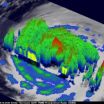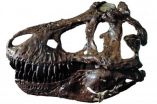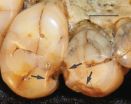(Press-News.org) NASA's Tropical Rainfall Measuring Mission (TRMM) satellite has provided a 3-D look at the power "under the hood" (of clouds) in powerful Category 4 Hurricane Igor as it heads toward Bermuda. In the meantime, Igor is creating dangerous surf in the eastern Atlantic, and it will affect the U.S. East coast later today. Igor is an extremely dangerous category four hurricane on the Saffir-Simpson hurricane wind scale today, Sept. 16, and he is expected to remain a large and powerful hurricane over the next several days.
The TRMM satellite, operated by NASA and the Japanese Space Agency covers the tropics daily, and provides two dimensional views of rainfall rates within a tropical cyclone. TRMM data are also used to give forecasters a 3 dimensional look at a storm's cloud heights and rainfall, which are extremely helpful in forecasting. The National Hurricane Center in Miami, Fla. who does the forecasting for tropical cyclones utilizes TRMM data in their forecasts.
A 3-D image was created by Hal Pierce at NASA's Goddard Space Flight Center, Greenbelt, Md. using data from TRMM's Precipitation Radar (PR) instrument on Sept. 15 at 0353 UTC (Sept. 14 at 11:53 p.m. EDT). The image revealed towering clouds, or "hot towers" over 15 kilometers (9 miles) high. Those high hot towers are an indication of a strong storm.
The 3-D image also showed that Igor's eye was still very distinct but the southwestern portion of the eye wall had eroded. In addition, the image showed a large area of heavy rainfall, falling at about 2 inches per hour. For more information about how TRMM looks at rainfall, visit NASA's TRMM website at: http://trmm.gsfc.nasa.gov/. TRMM is a joint mission between NASA and the Japanese space agency JAXA.
At 5 a.m. EDT on Sept. 16, Igor's winds had increased back up to 145 mph. It was located about 440 miles east-northeast of the Northern Leeward Islands, which is about 955 miles south-southeast of Bermuda. Igor's center was near 20.5 North and 56.8 West. Igor's estimated minimum central pressure is 929 millibars. Igor is moving toward the west-northwest near 7 mph and a turn toward the northwest and an increase in forward speed are expected over the next couple of days, according to the National Hurricane Center. Igor continues to be a huge hurricane. Hurricane winds extend out 70 miles from his center, and tropical storm force winds extend out 275 from his center, about the same distance as they were on Sept. 15.
Because Igor is so powerful and so large, he's generating large swells at sea that are currently affecting the Leeward Islands, Puerto Rico and the Virgin Islands. Those large swells and dangerous surf are expected in the Bahamas today and through the weekend. Igor's dangerous surf will also reach the East Coast of the United States later today and last through the weekend. That means trouble for beachgoers as these swells cause heavy surf and rip tides.
When Hurricane Earl brushed the U.S. East Coast in the first week of September it created the same surf conditions expected with Igor. Over a weekend as Earl lingered, more than 100 people were rescued off of the Delaware, Maryland and New Jersey beaches because of deadly rip tides.
INFORMATION:
NASA's 3-D look into Hurricane Igor's heavy rainfall
2010-09-16
ELSE PRESS RELEASES FROM THIS DATE:
Scientific understanding of T. rex revised by a decade of new research and discovery
2010-09-16
We've all heard this story: the Late Cretaceous of Asia and North America—about 65 million years ago—was dominated by several large-headed, bipedal predatory dinosaurs like Tyrannosaurus rex and Tarbosaurus that had tiny arms. But a decade of new fossil discoveries that have more than doubled the number of known tyrannosaur species has changed this tale. Older and smaller tyrannosaurs have made the evolutionary tree of this group richer and more complex. Furthermore, a series of innovative research projects on topics like bone growth and biomechanics have added an enormous ...
Beating blood clots: Reducing your risk before hip replacement surgery
2010-09-16
Risk factors for venous thromboembolism after total hip replacement (THR) surgery were identified in a new study published in the September 2010 issue of The Journal of Bone and Joint Surgery (JBJS). While the rate of thromboembolism has been significantly reduced through medication, understanding the risk factors could further reduce the likelihood of patients developing this potentially fatal complication.
Two of the most common manifestations of a thromboembolism include:
Deep vein thrombosis (DVT), in which the blood clot forms in a deep vein, commonly in the thigh ...
Placebo effect significantly improves women's sexual satisfaction, study shows
2010-09-16
AUSTIN, Texas — Many women with low sex drives reported greater sexual satisfaction after taking a placebo, according to new psychology research from The University of Texas at Austin and Baylor College of Medicine.
The study was conducted by Cindy Meston, a clinical psychology professor at The University of Texas at Austin, and Andrea Bradford, a 2009 University of Texas at Austin graduate and postdoctoral fellow in the Department of Family and Community Medicine at Baylor College of Medicine. They found that opening a new line of communication about sex can have a positive ...
3-D computer simulations help envision supernovae explosions
2010-09-16
For scientists, supernovae are true superstars -- massive explosions of huge, dying stars that shine light on the shape and fate of the universe.
For a brief burst of time, supernovae can radiate more energy than the sun will emit in its lifetime. With the potential energy of 25 hundred trillion trillion nuclear weapons, they can outshine entire galaxies, producing some of the biggest explosions ever seen, and helping track distances across the cosmos.
Now, a Princeton-led team has found a way to make computer simulations of supernovae exploding in three dimensions, ...
Asthma and cavities both common in kids but not linked
2010-09-16
INDIANAPOLIS – There is no apparent link between asthma and tooth decay, according to a study published in the September 2010 issue of the Journal of the American Dental Association.
"Is There a Relationship between Asthma and Dental Caries?: A Critical Review of the Literature" examined the 27 separate studies which looked for a link between asthma and cavities that were reported in 29 papers published between 1976 and March 2010.
"The notion that there is a link between asthma and tooth decay may have its origin in anecdotal statements by emergency room workers who ...
Disease transmission model says media coverage cuts infection rate and pandemic extent
2010-09-16
At the first sign of a disease pandemic, public health officials should begin strongly communicating about the extent of the outbreak and the steps that can be taken by the public to avoid infection. That's the recommendation of two mathematical biologists who have modified the most widely used infectious disease transmission model to account for the impact of news media coverage.
During outbreaks of serious infectious diseases, many individuals closely follow media reports and as a result, take precautions to protect themselves against the disease. These precautions ...
October 2010 Lithosphere highlights
2010-09-16
Boulder, CO, USA – The October LITHOSPHERE examines the following key questions: (1) how do large volumes of silicic magma contribute to the growth of continental crust?; (2) how does the Tibetan Plateau grow?; (3) what are the dynamics of the lithosphere beneath the Eastern Carpathians in Romania?; (4) what's really true about the Mojave-Snow Lake fault hypothesis?; (5) can Earth's pulse be measured at its hotspots?; and (6) what is the nature of the Moho in NW Canada?
Keywords: Philipsburg Batholith, Tibetan Plateau, Carpathians, Mojave-Snow Lake fault, hotspots, Moho.
Highlights ...
A chip off the early hominin tooth
2010-09-16
Were our early mammalian ancestors vegetarians, vegans or omnivores? It's difficult for anthropologists to determine the diet of early mammalians because current fossil analysis provides too little information. But a new method that measures the size of chips in tooth fossils can help determine the kinds of foods these early humans consumed.
Prof. Herzl Chai of Tel Aviv University's School of Mechanical Engineering, in collaboration with scientists from George Washington University and the U.S. National Institute of Standards and Technology (NIST), has developed an equation ...
Undergraduate research highlighted in DNA and Cell Biology Journal
2010-09-16
New Rochelle, NY, September 16, 2010—Not only do undergraduate students gain valuable hands-on experience by participating in scientific research projects, but they also make meaningful contributions, examples of which are highlighted in the current special issue of DNA and Cell Biology, a peer-reviewed journal published by Mary Ann Liebert, Inc. The issue is available free online.
This special issue features a collection of papers reporting on successful research projects in which undergraduate students played a significant role, "and undoubtedly learned much in the ...
Bacteria identified that may lead to inflammatory bowel disease in certain individuals
2010-09-16
Certain bacteria that inhabit the intestine provide the environmental trigger that initiates and perpetuates chronic intestinal inflammation in individuals who are genetically susceptible to inflammatory bowel disease (IBD), a study led by Harvard School of Public Health researchers has found.
Inflammatory bowel disease results from a loss of homeostasis, or balance, between the immune system and the microbes that inhabit the intestine. "In this study, we identified two microbes that instigate gut inflammation that leads to inflammatory bowel disease in mice," said ...





